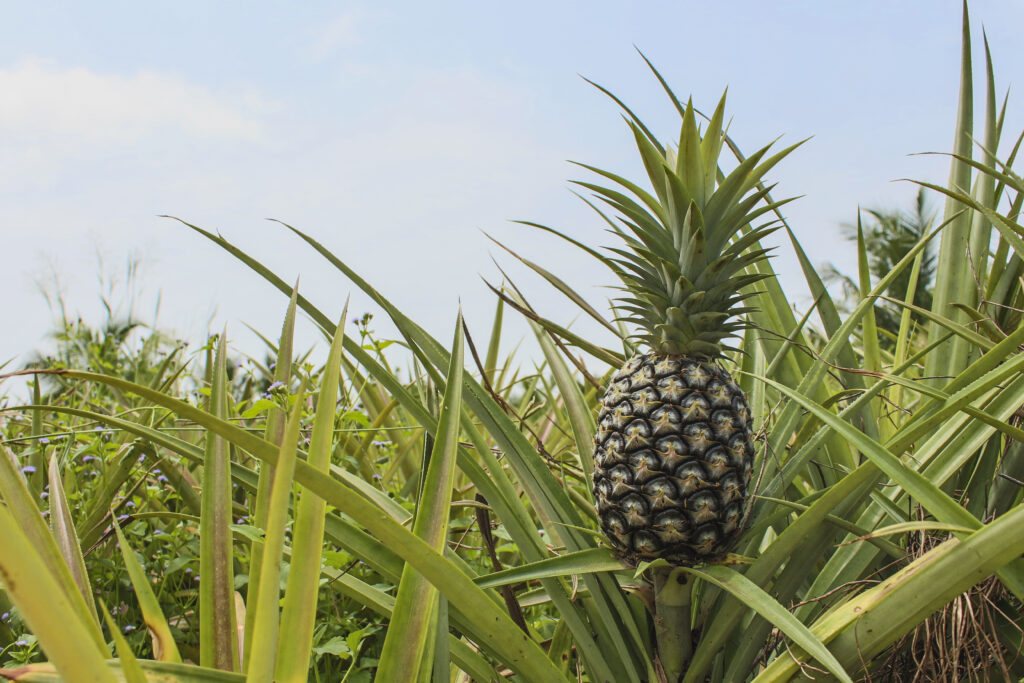Pineapple
General information
The pineapple (Ananas comosus) continues to enjoy worldwide popularity due to its sweet and aromatic taste and its vitamin content (just half a pineapple covers the vitamin C requirement of an adult). The shrub-like plant was cultivated by the indigenous peoples of South America in the areas along the Amazon over 4,000 years ago. In addition to eating the actual fruit, other parts of the pineapple plant could also be used, particularly in the art of bow making. Botanically, the Ananas comosus belongs to the Bromeliaceae (bromeliad) family, whereby the term “Ananas” comes from the Guarani language, which was once widely spoken in central South America and means “delicious fruit”.

Growing regions
According to the Food and Agriculture Organization (FAO), global pineapple production in 2022 was around 2.9 million tons. The pineapple plant originally comes from the tropics of South America. Christopher Columbus brought it to Europe, where it quickly became very popular. Today, pineapple cultivation is widespread in the (sub)tropical regions of Central and South America, Central Africa and South East Asia. The leading producing countries are Indonesia, the Philippines, Costa Rica, China and Brazil. This map shows the 10 countries that produced the highest quantity of pineapple products in 2022 according to the FAO. In addition, Ghana and the Ivory Coast are shown, which are not among the top 10 producing countries, but nevertheless play an important role and in this case represent Africa as a growing region.
Cultivation and harvest
The ideal conditions for growing pineapple plants are constantly high temperatures between 23 and 30°C. Even at temperatures below 20°C, growth decreases significantly; below 15°C, the plant will quickly die. In addition, the average annual precipitation should ideally be between 1000 and 1500 mm and the pH value of the soil should be below 5.5, i.e. slightly acidic. However, these are only the ideal conditions, as the Ananas comosus is much less demanding overall than many other crop plants. It is particularly resistant to heat and drought and can be grown in almost any soil, as long as the soil has good water drainage so that no waterlogging can occur. Pineapples are usually cultivated in the form of large-scale monocultures, with a high level of pesticide use and the use of large machinery. After initial planting, the fruit can be harvested after approx. 14 to 16 months. After that, the harvest intervals become shorter, but the yield of the plant also decreases quite rapidly.


Products
After harvesting, the pineapple fruits are washed, selected, treated with fungicides and then cooled and packaged for onward transportation. 80% of the pineapple available worldwide is part of already processed products such as pineapple juice, jams, sweets and various forms of canned pineapple. Whole fruits therefore only make up around a fifth of the global supply. In addition to the fruit, other parts of the plant can also be used, such as certain fibers from the plant for the production of textiles, or microcrystalline cellulose from the plant for the production of pharmaceutical products.
Certification
The two most common labels for pineapple production are the Rainforest Alliance and Fairtrade. The products predominantly come from Costa Rica and parts of Africa (mostly Ghana or the Ivory Coast). These labels are intended to guarantee smallholder cooperatives more stable prices and long-term trading relationships. In addition, these labels stand for better working conditions and, last but not least, better environmental protection than conventional cultivation.


Sustainability
In order to counteract the increasing deforestation, projects are being launched worldwide where pineapples are grown together with other plants in so-called agroforestry systems. The pineapple plant, for example, can be grown and cultivated very well under cashew or mango trees, as it also grows in the shade without any problems. A protective layer of mulch can help prevent soil erosion on pineapple plantations. For smaller farmers in particular, it is desirable to cultivate an alternating crop rotation that is ideally integrated into the farm’s own cycle system. For example, the Rainforest Alliance seal recommends alternating between pineapple plants and fodder plants for animals, which in turn can be used for the farm’s own needs. This keeps the soil fertile for longer, promotes biodiversity in the surrounding area and at the same time ensures that farming is as environmentally friendly as possible.
Challenges
Pineapple plants are usually grown in large-scale monocultures. Existing forests are often cut down in order to preserve such contiguous flat areas for agriculture. In addition, although the pineapple plant is relatively undemanding in terms of soil conditions and temperature resistance, it requires a high level of pesticide use. Costa Rica, one of the world’s main pineapple-growing countries, is the world leader in the use of such pesticides. In addition to the resulting deterioration in soil quality, the use of pesticides also contaminates the groundwater and, due to the high level of soil erosion on pineapple plantations, polluted water can easily find its way into surrounding bodies of water and cause further damage. Workers can also suffer under these circumstances if the current regulations are not observed. This risk also exists in Costa Rica, for example, as illegal migrant workers from Nicaragua often work in poor conditions on pineapple plantations, particularly in the north of the country. After the pineapple harvest, old plant remains are often burned in order to contain the spread of flies and other pests, which could otherwise become a problem for surrounding farms. This procedure in turn releases greenhouse gases that are harmful to the environment. Consumers can also make a small contribution to more sustainable pineapple cultivation through conscious consumption and the purchase of products with the appropriate labels.
